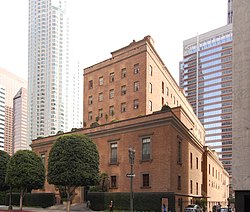
The Bohemian Club is a private club with two locations: a city clubhouse in the Nob Hill district of San Francisco, California, and the Bohemian Grove, a retreat north of the city in Sonoma County. Founded in 1872 from a regular meeting of journalists, artists, and musicians, it soon began to accept businessmen and entrepreneurs as permanent members, as well as offering temporary membership to university presidents and military commanders who were serving in the San Francisco Bay Area. Today, the club has a membership of many local and global leaders, ranging from artists and musicians to businessmen. Membership is restricted to men only.

Los Angeles Athletic Club (LAAC) is a privately owned athletic club and social club in Los Angeles, California, United States. Established in 1880, the club is today best known for its John R. Wooden Award presented to the outstanding men's and women's college basketball player of each year.

The Colony Club is a women-only private social club in New York City. Founded in 1903 by Florence Jaffray Harriman, wife of J. Borden Harriman, as the first social club established in New York City by and for women, it was modeled on similar gentlemen's clubs. Today, men are admitted as guests.

The University Club of New York is a private social club at 1 West 54th Street and Fifth Avenue in the Midtown Manhattan neighborhood of New York City. Founded to celebrate the union of social duty and intellectual life, the club was chartered in 1865 for the "promotion of literature and art". The club is not affiliated with any other University Club or college alumni clubs. According to The New York Times, the club is considered one of the most prestigious in New York City.
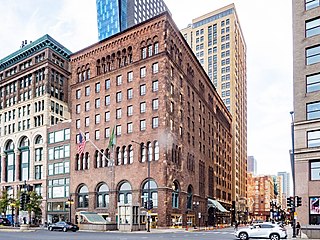
The Chicago Club, founded in 1869, is a private social club located at 81 East Van Buren Street at Michigan Avenue in the Loop neighborhood of Chicago, Illinois, in the United States. Its membership has included many of Chicago's most prominent businessmen, politicians, and families.

The Harvard Club of New York City, commonly called The Harvard Club, is a private social club located in Midtown Manhattan, New York City. Its membership is limited to alumni, faculty and board members of Harvard University.

Los Angeles Nurses' Club is a clubhouse and apartment building for nurses located in the Westlake district of Central Los Angeles, California.
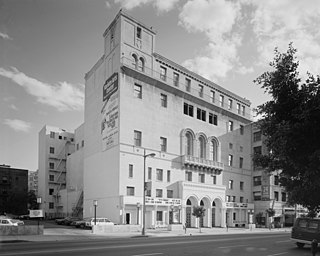
The Friday Morning Club building is located in Downtown Los Angeles, California. It was the second home of the women's club also named the Friday Morning Club (FMC), for 61 years.

The Alibi Club is a traditional gentlemen's private club in Washington, D.C. Its members consist of the Washington elite, including presidents, senators, and diplomats, among other prominent figures.

The Arlington Club is a private social club organized in 1867 by 35 business and banking leaders of Portland in the US state of Oregon. First called the Social Club and later renamed the Arlington Club, it offered its all-male, largely white membership consisting of banking and business leadership.
Membership discrimination in California social clubs has been based on sex, race, religion, political views and social standing. In the late 1980s, a successful effort was made in many of the clubs to open up membership first to racial or religious minorities and then to women. Strictly private clubs that are not open to the public, and for which tax exemptions are not claimed, maintain their right to discriminate on the basis of sex or race, and all clubs can discriminate on the basis of social standing.
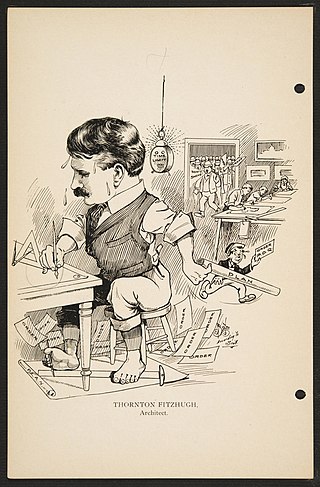
Thornton Fitzhugh (1864–1933) was an American architect. Among his major works are the Beaux Arts and Romanesque Pacific Electric Building in downtown Los Angeles, California, and a number others which are listed on the U.S. National Register of Historic Places.

William F. Curlett and Alexander Edward Curlett were a father-and-son pair of architects. They worked together as partners under the name of William Curlett and Son, Architects from c. 1908–1916. Aleck Curlett partnered with Claud Beelman as Curlett & Beelman (1919–1932).
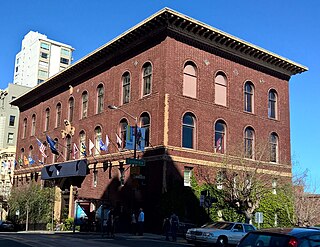
The University Club of San Francisco is a private social club located atop Nob Hill in San Francisco, California. Notable members have included President Herbert Hoover and conservationist John Muir.

Abraham Wesley Eager (1864–1930) was a Canadian-born American architect. He designed many houses in Los Angeles, California.

The Tuna Club of Avalon is a private members's club in Avalon on Santa Catalina Island in California.

The Calgary Petroleum Club is a private social club in Calgary, Alberta. The club was founded in 1948 as a gentlemen's club catered to executives in the petroleum industry, but since 1989 has been mixed-sex. Membership in the Calgary Petroleum Club has been described as the "pinnacle of social and corporate achievement in a one-industry town."
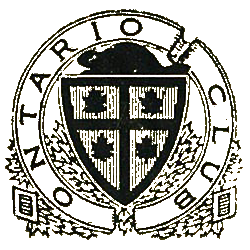
The Ontario Club was a private club in Toronto, Ontario that existed from 1909 to 2010. The club was founded as a gentlemen's club, but in 1978 became mixed-sex. The Ontario was organised as a home for members of the Liberal Party of Canada, and as such, was the counterpart to the Albany Club, which was for members of the Conservative Party of Canada. From 1912 to 1969, the Ontario Club had a clubhouse on Wellington Street. After it sold the property to the Canadian Imperial Bank of Commerce, from 1972 to 2007, it occupied the top floor of Commerce Court South. In 2010, the Ontario Club merged into the National Club.
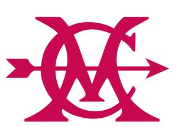
The Metropolitan Club is a women's club in San Francisco, California. Their clubhouse is listed on the National Register of Historic Places as the Woman's Athletic Club of San Francisco.
